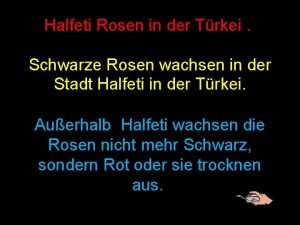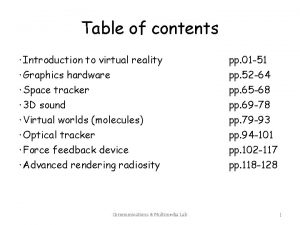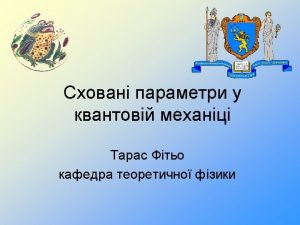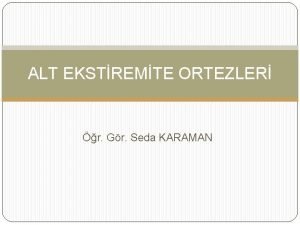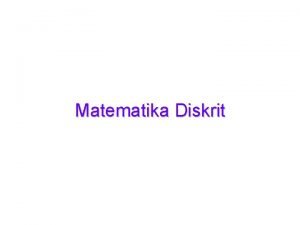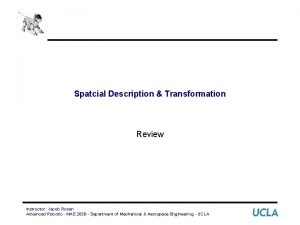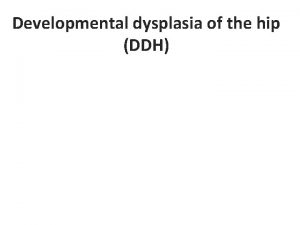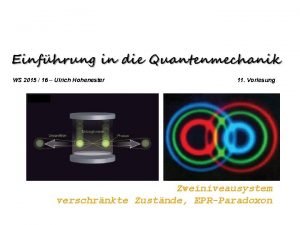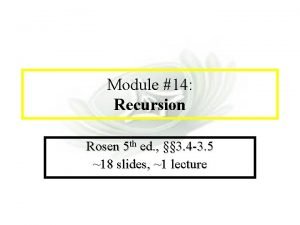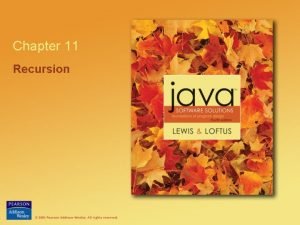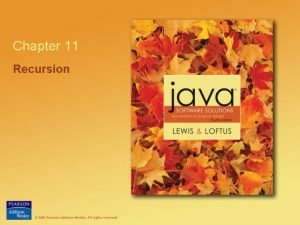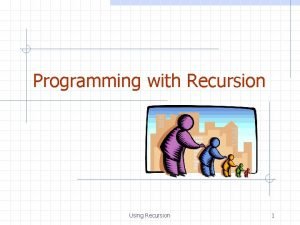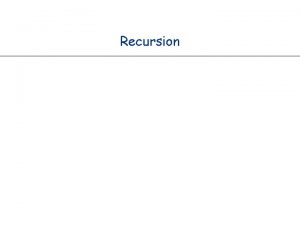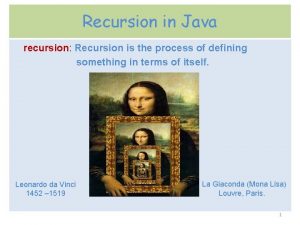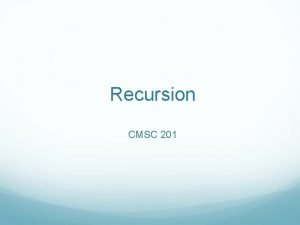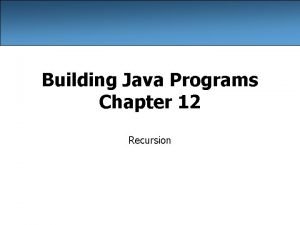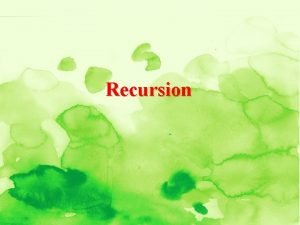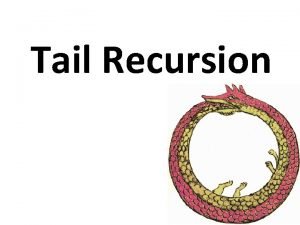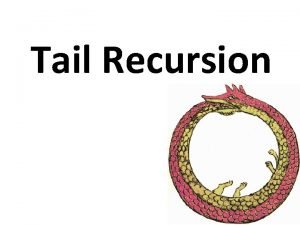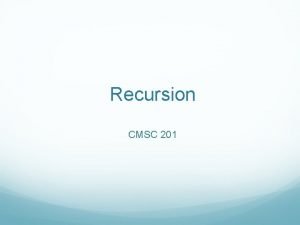Module 14 Recursion Module 14 Recursion Rosen 5


















- Slides: 18

Module #14 - Recursion Module #14: Recursion Rosen 5 th ed. , §§ 3. 4 -3. 5 ~18 slides, ~1 lecture 12/2/2020 (c)2001 -2003, Michael P. Frank 1

Module #14 - Recursion § 3. 4: Recursive Definitions • In induction, we prove all members of an infinite set have some property P by proving the truth for larger members in terms of that of smaller members. • In recursive definitions, we similarly define a function, a predicate or a set over an infinite number of elements by defining the function or predicate value or set-membership of larger elements in terms of that of smaller ones. 12/2/2020 (c)2001 -2003, Michael P. Frank 2

Module #14 - Recursion • Recursion is a general term for the practice of defining an object in terms of itself (or of part of itself). • An inductive proof establishes the truth of P(n+1) recursively in terms of P(n). • There also recursive algorithms, definitions, functions, sequences, and sets. 12/2/2020 (c)2001 -2003, Michael P. Frank 3

Module #14 - Recursion Recursively Defined Functions • Simplest case: One way to define a function f: N S (for any set S) or series an=f(n) is to: – Define f(0). – For n>0, define f(n) in terms of f(0), …, f(n− 1). • E. g. : Define the series an : ≡ 2 n recursively: – Let a 0 : ≡ 1. – For n>0, let an : ≡ 2 an-1. 12/2/2020 (c)2001 -2003, Michael P. Frank 4

Module #14 - Recursion Another Example • Suppose we define f(n) for all n N recursively by: – Let f(0)=3 – For all n N, let f(n+1)=2 f(n)+3 • What are the values of the following? – f(1)= 9 12/2/2020 f(2)= 21 f(3)= 45 f(4)= 93 (c)2001 -2003, Michael P. Frank 5

Module #14 - Recursion Recursive definition of Factorial • Give an inductive definition of the factorial function F(n) : ≡ n! : ≡ 2 3 … n. – Base case: F(0) : ≡ 1 – Recursive part: F(n) : ≡ n F(n-1). • • • 12/2/2020 F(1)=1 F(2)=2 F(3)=6 (c)2001 -2003, Michael P. Frank 6

Module #14 - Recursion The Fibonacci Series • The Fibonacci series fn≥ 0 is a famous series defined by: f 0 : ≡ 0, f 1 : ≡ 1, fn≥ 2 : ≡ fn− 1 + fn− 2 0 1 1 2 3 58 13 12/2/2020 Leonardo Fibonacci 1170 -1250 (c)2001 -2003, Michael P. Frank 7

Module #14 - Recursion Inductive Proof about Fib. series Implicitly for all n N • Theorem: fn < 2 n. • Proof: By induction. Note use of 0 Base cases: f 0 = 0 < 2 = 1 base cases of f 1 = 1 < 21 = 2 recursive def’n. Inductive step: Use 2 nd principle of induction (strong induction). Assume k<n, fk < 2 k. Then fn = fn− 1 + fn− 2 is < 2 n− 1 + 2 n− 2 < 2 n− 1 + 2 n− 1 = 2 n. ■ 12/2/2020 (c)2001 -2003, Michael P. Frank 8

Module #14 - Recursion Recursively Defined Sets • An infinite set S may be defined recursively, by giving: – A small finite set of base elements of S. – A rule for constructing new elements of S from previously-established elements. – Implicitly, S has no other elements but these. • Example: Let 3 S, and let x+y S if x, y S. What is S? 12/2/2020 (c)2001 -2003, Michael P. Frank 9

Module #14 - Recursion The Set of All Strings • Given an alphabet Σ, the set Σ* of all strings over Σ can be recursively defined as: ε Σ* (ε : ≡ “”, the empty string) Book uses λ w Σ* x Σ → wx Σ* • Exercise: Prove that this definition is equivalent to our old one: 12/2/2020 (c)2001 -2003, Michael P. Frank 10

Module #14 - Recursion Recursive Algorithms (§ 3. 5) • Recursive definitions can be used to describe algorithms as well as functions and sets. • Example: A procedure to compute an. procedure power(a≠ 0: real, n N) if n = 0 then return 1 else return a · power(a, n− 1) 12/2/2020 (c)2001 -2003, Michael P. Frank 11

Module #14 - Recursion Efficiency of Recursive Algorithms • The time complexity of a recursive algorithm may depend critically on the number of recursive calls it makes. • Example: Modular exponentiation to a power n can take log(n) time if done right, but linear time if done slightly differently. – Task: Compute bn mod m, where m≥ 2, n≥ 0, and 1≤b<m. 12/2/2020 (c)2001 -2003, Michael P. Frank 12

Module #14 - Recursion Modular Exponentiation Alg. #1 Uses the fact that bn = b·bn− 1 and that x·y mod m = x·(y mod m) mod m. (Prove the latter theorem at home. ) procedure mpower(b≥ 1, n≥ 0, m>b N) {Returns bn mod m. } if n=0 then return 1 else return (b·mpower(b, n− 1, m)) mod m Note this algorithm takes Θ(n) steps! 12/2/2020 (c)2001 -2003, Michael P. Frank 13

Module #14 - Recursion Modular Exponentiation Alg. #2 • Uses the fact that b 2 k = bk· 2 = (bk)2. procedure mpower(b, n, m) {same signature} if n=0 then return 1 else if 2|n then return mpower(b, n/2, m)2 mod m else return (mpower(b, n− 1, m)·b) mod m What is its time complexity? Θ(log n) steps 12/2/2020 (c)2001 -2003, Michael P. Frank 14

Module #14 - Recursion A Slight Variation Nearly identical but takes Θ(n) time instead! procedure mpower(b, n, m) {same signature} if n=0 then return 1 else if 2|n then return (mpower(b, n/2, m)· mpower(b, n/2, m)) mod m else return (mpower(b, n− 1, m)·b) mod m The number of recursive calls made is critical. 12/2/2020 (c)2001 -2003, Michael P. Frank 15

Module #14 - Recursion Recursive Euclid’s Algorithm procedure gcd(a, b N) if a = 0 then return b else return gcd(b mod a, a) • Note recursive algorithms are often simpler to code than iterative ones… • However, they can consume more stack space, if your compiler is not smart enough. 12/2/2020 (c)2001 -2003, Michael P. Frank 16

Module #14 - Recursion Merge Sort procedure sort(L = 1, …, n) if n>1 then m : = n/2 {this is rough ½-way point} L : = merge(sort( 1, …, m), sort( m+1, …, n)) return L • The merge takes Θ(n) steps, and merge-sort takes Θ(n log n). 12/2/2020 (c)2001 -2003, Michael P. Frank 17

Module #14 - Recursion Merge Routine procedure merge(A, B: sorted lists) L = empty list i: =0, j: =0, k: =0 while i<|A| j<|B| {|A| is length of A} if i=|A| then Lk : = Bj; j : = j + 1 else if j=|B| then Lk : = Ai; i : = i + 1 else if Ai < Bj then Lk : = Ai; i : = i + 1 else Lk : = Bj; j : = j + 1 k : = k+1 return L Takes Θ(|A|+|B|) time 12/2/2020 (c)2001 -2003, Michael P. Frank 18
 Eddie rosen brian rosen
Eddie rosen brian rosen Rosen die ich an dich verschenke
Rosen die ich an dich verschenke To understand recursion you must understand recursion
To understand recursion you must understand recursion C device module module 1
C device module module 1 Gibt es schwarze rose
Gibt es schwarze rose David rosen sega
David rosen sega Epr einstein podolsky rosen
Epr einstein podolsky rosen Sophie rosen
Sophie rosen Gece moldu ortez
Gece moldu ortez Rosen discrete mathematics solutions
Rosen discrete mathematics solutions Jacob rosen ucla
Jacob rosen ucla John rosen
John rosen Ncblpc
Ncblpc The car trip michael rosen
The car trip michael rosen Andy rosen basketball
Andy rosen basketball Ddh définition
Ddh définition Drew rosen
Drew rosen Writing a recount of a school trip
Writing a recount of a school trip Einstein-podolsky-rosen-paradoxon
Einstein-podolsky-rosen-paradoxon




